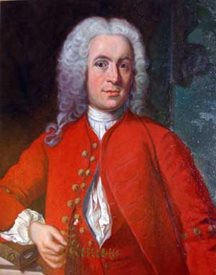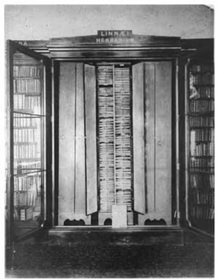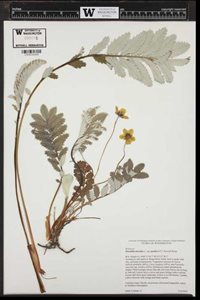History and Modern Uses
History and Modern Uses of a Herbarium
This article can be printed for classroom use – download article (.pdf).
The History of Herbaria
The term herbarium was first used as a collection of dried medicinal plants cataloged within a bound book3.
In the 16th century, Luca Ghini (1490?-1556) is credited to be the first person to press and preserve plants under pressure, then bind the specimens within a book3. He was a Botany Professor at the University of Bologna, Italy. This practice quickly became the usual practice throughout Europe. Specimens were housed in researchers’ personal collections, and extra specimens were traded with other botanists3.


In the 18th century, Carl Linneaus (1707-1778), known as the “Father of Taxonomy” was faced with a challenge while preserving plants according to this Italian practice. As his collections expanded, it was difficult to catalog when binding the specimens within a book. He came up with a system that mounted one specimen per large sheet of paper7. After that, it would be cataloged with other closely-related plants and stored in cabinets, which provided room to add new material and allowed the shelves to function as a file cabinet. He decided the sheets of paper should be one size, that way when traded with other botanists, the collection remained uniform7. These standards are still used today, several hundred years later.



Not only do the standards remain, but so do the specimens. The pressed specimen (above), Delphinium grandiflorum, with blue flowers was in Carl Linneaus’ collection (likely preserved during his lifetime)4. The specimen is now housed at The Linnean Society of London and was photographed in 2001 to be added to a digital collection4. The flowers are still blue, papery and translucent, and pollen is still visible. For a close-up of the specimen, visit http://linnean-online.org/6501/.
The Digital Age
While the basic principles of collecting, preserving, and cataloging specimens are generations old, herbaria are not falling behind in the digital age. Many herbaria are no longer housed in private collections, but managed for the general public, usually by museums and universities. In the last ten years, many of the collections have been photographed and made available online, allowing anyone in the world to view the specimens from their home. The University of Washington Burke Herbarium displays their collection digitally with other herbaria on the Consortium of Pacific Northwest Herbaria located at http://www.pnwherbaria.org/index.php. UW Bothell Herbarium is hoping to be published on this website by the end of 2017.
How a Herbarium Functions as a Museum, Library, and Lab
A herbarium is a storage facility that catalogues and holds dried plant specimens secured onto sheets of paper. There are specimens that have been collected by famous scientists, like Luca Ghini and Carl Linneaus. A herbarium is the depository where these plants are stored and exhibited because of their historical and cultural significance. Not only are famous collectors featured, but the rare specimens are too. Some species have become extinct, or are evolving, and having records of the plants that span centuries is invaluable to taxonomy. Museums also house beautiful artwork to look at, and herbarium specimens are no exception. A cross of scientific documentation and artistic composition, many people like to just look through the specimens because they are lovely to look at. Eve Rickenbaker, Collections Manager at the UW Otis Hyde Herbarium in Seattle, says, “It is always Springtime at the herbarium, even on cold gloomy winter days in Seattle. Whenever I feel bad, I just open a cabinet.”

Since plants are collected when reproductive structures are present (flower/fruit) the specimens are available year-round. This allows researchers to view the specimens outside of their seasonal availability. In addition to the collection being available off-season, the collection is also accessible to interested parties that may be physically unable to do their own field work or manage difficult terrain.
Herbaria collaborate with other herbaria and function as a worldwide library. Instead of walls of book shelves, there are cabinets of plant cards. Once a herbarium is registered officially, it can trade specimens with other herbaria2. If there is a scientist at a UW herbarium studying the plant wapato, Saggitaria latifolia, and she wants to see how the form (phenotype) changes according to geographic location, the UW herbarium can borrow specimens from other North American herbaria. The UW herbarium will host the specimens so the scientist can view a comprehensive collection from many places like Florida, Minnesota, Texas, California, and Alaska all in one room at the same time. When the scientist is finished with her research, the specimens will be returned to the original herbaria.
A herbarium is also a scientific laboratory and an extension to classrooms for hand-on learning. Real plants, not photographs, are stored, so scientists can use real plant tissues for experiments. Collectors may store extra tissues in an envelope on the plant card for this purpose. Scientists can successfully pull DNA and proteins from the leaves and flowers, even if they are one hundred years old2. A herbarium also has botanical tools, including a microscope, to view the specimens’ small features up close which is an ideal place for students to learn about plant identification and taxonomy.
Information Listed with Each Specimen
Outdoors in the field, the collector will choose a set of plants they want preserved. At this time, they would document what species they are collecting (to the best of their knowledge), as well as valuable information about the ecology and environment. When the collector returns to the lab, they will use a dichotomous key and other resources to help narrow down the identity of the species. This information is listed on the placard (lower right hand corner) which also lists the family name, genus, species, GPS points, collector name, collection number, and date. The herbarium logo and accession number are stamped in an upper corner. This code is the identifying number used to organize the herbarium’s database, and used when the specimen is cited by a scientist. The last item on the specimen is a barcode, which is scanned and helpful when managing the digital collection.
Written by Sarah Verlinde-Azofeifa, 24 October 2016
Resources:
- Carl Linneaus portrait [Internet]. 1738 [cited 2016 Oct 24]. Available from: https://en.wikipedia.org/wiki/Carl_Linnaeus#/media/File:LinnaeusWeddingPortrait.jpg
- Culley, TM, editor. 2013. Applications in plant sciences. Department of Biological Sciences, University of Cincinnati.
- Forman, L, Bridson DM, editors, and Royal Botanic Gardens, Kew. 1998. The Herbarium handbook (3rd ed). Richmond (Eng): Royal Botanic Gardens, Kew.
- Delphinium grandiflorum [Internet]; circa 18th century [cited 2016 Oct 24]. (The Linnean Herbarium Acc # LINN 694.7). Available from: http://linnean-online.org/linnaean_herbarium.html
- Luca Ghini. Circa 1500-1556 [Internet]; [cited 2016 Oct 24]. Available from: https://lizzyoungbookseller.files.wordpress.com/2014/02/luca_ghini.jpg?w=210&h=284
- Simmons, JC [Internet]; [cited 2016 Oct 24]. Bound herbarium of ferns and mosses. Available from: https://www.brown.edu/research/projects/herbarium/about/what-herbarium.
- Müller-Wille, S. 2006. Linnaeus’ herbarium cabinet: a piece of furniture and its function, Endeavour (30): 60-64. Available from: http://dx.doi.org/10.1016/j.endeavour.2006.03.001.
- Verlinde-Azofeifa, S. 2016. Photo of Potentilla anserina herbarium specimen (UW Bothell Herbarium Acc # 000008).